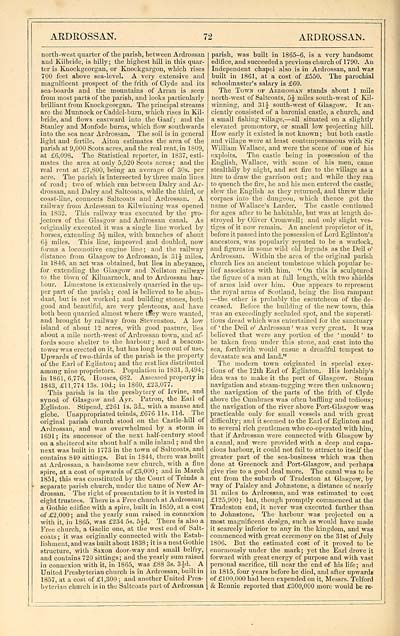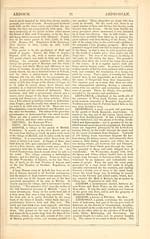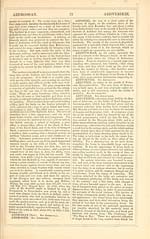Download files
Complete book:
Individual page:
Thumbnail gallery: Grid view | List view

ARDROSSAN.
72
ARDROSSAN.
north-west quailer of the parish, between Ardrossan
and Kilbride, is hilly; the highest hill in this quar-
ter is Knockgeorgan, or Knockgargon, which rises
700 feet above sea-level. A very extensive and
magnificent prospect of the frith of Clyde and its
sea-boards and the mountains of Arran is seen
from most parts of the parish, and looks particularly
brilliant from Knockgeorgan. The principal streams
are the Munnock or Caddel-burn, which rises in Kil-
bride, and flows eastward into the Gaaf ; and the
Stanley and Monfode burns, which flow southwards
into the sea near Ardrossan. The soil is in general
light and fertile. Aiton estimates the area of the
parish at 9,000 Scots acres, and the real rent, in 1809,
at £6,098. The Statistical reporter, in 1S37, esti-
mates the area at only 5,520 Scots acres ; and the
real rent at £7,800, being an average of 30s. per
acre. The parish is intersected by three main lines
of road ; two of which run between Dairy and Ar-
drossan, and Dairy and Saltcoats, while the third, or
coast-line, connects Saltcoats and Ardrossan. A
railway from Ardrossan to Kilwinning was opened
in 1832. This railway was executed by the pro-
jectors of the Glasgow and Ardrossan canal. As
originally executed it was a single line worked by
horses, extending 5£ miles, with branches of about
6J miles. This line, improved and doubled, now
forms a locomotive engine line ; and the railway
distance from Glasgow to Ardrossan, is 31J miles.
In 1846, an act was obtained, but lies in abeyance,
for extending the Glasgow and Neilston railway
to the town of Kilmarnock, and to Ardrossan har-
bour. Limestone is extensively quarried in the up-
per part of the parish ; coal is believed to be abun-
dant, but is not worked ; and building stones, both
good and beautiful, are very plenteous, and have
both been quarried almost where tfiey were wanted,
and brought by railway from Stevenston. A low
island of about 12 acres, with good pasture, lies
about a mile north-west of Ardrossan town, and af-
fords some shelter to the harbour ; and a beacon-
tower was erected on it, but has long been out of use.
Upwards of two-thirds of the parish is the property
of the Earl of Eglinton; and the rest lies distributed
among nine proprietors. Population in 1831, 3,494;
in 1861, 6,776. Houses, 682. Assessed property in
1843, £11,774 13s. 10d.; in 1860, £23,077.
This parish is in the presbytery of Irvine, and
synod of Glasgow and Ayr. Patron, the Earl of
Eglinton. Stipend, £261 Is. 3d., with a manse and
glebe. Unappropriated teinds, £676 lis. lid. _ The
original parish church stood on the Castle-hill of
Ardrossan, and was overwhelmed by a storm in
1691; its successor of the next half-century stood
on a sheltered site about half a mile inland ; and the
next was built in 1773 in the town of Saltcoats, and
contains 840 sittings. But in 1844, there was built
at Ardrossan, a handsome new church, with a fine
spire, at a cost of upwards of £3,000 ; and in March
1851, this was constituted by the Court of Teinds a
separate parish church, under the name of New Ar-
drossan. The right of presentation to it is vested in
eight trustees. There is a Free church at Ardrossan;
a Gothic edifice with a spire, built in 1859, at a cost
of £2,000; and the yearly sum raised in connexion
with it, in 1865, was £234 5s. 5Jd. There is also a
Free church, a Gaelic one, at the west end of Salt-
coats; it was originally connected with the Estab-
lishment, and was built about 1838 ; it is a neat Gothic
structure, with Saxon door-way and small belfry,
and contains 720 sittings; and the yearly sum raised
in connexion with it, in 1865, was £88 3s. 3£d. A
United Presbyterian church is in Ardrossan, built in
1857, at a cost of £1,300 ; and another United Pres-
byterian church is in the Saltcoats part of Ardrossan
parish, was built in 1865-6, is a very handsome
edifice, and succeeded a previous church of 1790. An
Independent chapel also is in Ardrossan, and was
built in 1861, at a cost of £550. The parochial
schoolmaster's salary is £60.
The Town op Ahdeossan stands about 1 mile
north-west of Saltcoats, 5J miles south-west of Kil-
winning, and 31£ south-west of Glasgow. It an-
ciently consisted of a baronial castle, a church, and
a small fishing village, — all situated on a slightly
elevated promontory, or small low projecting hill.
How early it existed is not known ; but both castle
and village were at least contemporaneous with Sir
William Wallace, and were the scene of one of his
exploits. The castle being in possession of the
English, Wallace, with some of his men, came
stealthily by night, and set fire to the village as a
lure to draw the garrison out ; and while they ran
to quench the fire, he and his men entered the castle,
slew the English as they returned, and threw their
corpses into the dungeon, which thence got the
name of Wallace's Larder. The castle continued
for ages after to be habitable, but was at length de-
stroyed by Oliver Cromwell; and only slight ves-
tiges of it now remain. An ancient proprietor of it,
before it passed into the possession of Lord Eglin ton's
ancestors, was popularly reputed to be a warlock,
and figures in some wild old legends as the Deil o'
Ardrossan. Within the area of the original parish
church lies an ancient tombstone which popular be-
lief associates with him. " On this is sculptured
the figure of a man at full length, with two shields
of arms laid over him. One appears to represent
the royal arms of Scotland, being the lion rampant
— the other is probably the escutcheon of the de-
ceased. Before the building of the new town, this
was an exceedingly secluded spot, and the supersti-
tious dread which was entertained for the sanctuary
of ' the Deil o' Ardrossan ' was very great. It was
believed that were any portion of the ' moidd ' to
be taken from under this stone, and cast into the
sea, forthwith would ensue a dreadful tempest to
devastate sea and land."
The modem town originated in special exer-
tions of the 12th Earl of Eglinton. His lordship's
idea was to make it the port of Glasgow. Steam
navigation and steam-tugging were then unknown ;
the navigation of the parts of the frith of Clyde
above the Cumbraes was often baffling and tedious ;
the navigation of the river above Port-Glasgow was
practicable only for small vessels and with great
difficulty ; and it seemed to the Earl of Eglinton and
to several rich gentlemen who co-operated with him,
that if Ardrossan were connected with Glasgow by
a canal, and were provided with a deep and capa-
cious harbour, it could not fail to attract to itself the
greater part of the sea-business which was then
done at Greenock and Port-Glasgow, and perhaps
give rise to a good deal more. The canal was to be
cut from the suburb of Tradeston at Glasgow, by
way of Paisley and Johnstone, a distance of nearly
31 miles to Ardrossan, and was estimated to cost
£125,900; but, though promptly commenced at the
Tradeston end, it never was executed farther than
to Johnstone. The harbour was projected on a
most magnificent design, such as would have made
it scarcely inferior to any in the kingdom, and was
commenced with great ceremony on the 31st of July
1806. But the estimated cost of it proved to be
enormously under the mark; yet the Earl drove it
forward with great energy of purpose and with vast
personal sacrifice, till near the end of his life ; and
in 1815, four years before he died, and after upwards
of £100,000 had been expended on it, Messrs. Telford
& Bennie reported that £300,000 more would be re-
72
ARDROSSAN.
north-west quailer of the parish, between Ardrossan
and Kilbride, is hilly; the highest hill in this quar-
ter is Knockgeorgan, or Knockgargon, which rises
700 feet above sea-level. A very extensive and
magnificent prospect of the frith of Clyde and its
sea-boards and the mountains of Arran is seen
from most parts of the parish, and looks particularly
brilliant from Knockgeorgan. The principal streams
are the Munnock or Caddel-burn, which rises in Kil-
bride, and flows eastward into the Gaaf ; and the
Stanley and Monfode burns, which flow southwards
into the sea near Ardrossan. The soil is in general
light and fertile. Aiton estimates the area of the
parish at 9,000 Scots acres, and the real rent, in 1809,
at £6,098. The Statistical reporter, in 1S37, esti-
mates the area at only 5,520 Scots acres ; and the
real rent at £7,800, being an average of 30s. per
acre. The parish is intersected by three main lines
of road ; two of which run between Dairy and Ar-
drossan, and Dairy and Saltcoats, while the third, or
coast-line, connects Saltcoats and Ardrossan. A
railway from Ardrossan to Kilwinning was opened
in 1832. This railway was executed by the pro-
jectors of the Glasgow and Ardrossan canal. As
originally executed it was a single line worked by
horses, extending 5£ miles, with branches of about
6J miles. This line, improved and doubled, now
forms a locomotive engine line ; and the railway
distance from Glasgow to Ardrossan, is 31J miles.
In 1846, an act was obtained, but lies in abeyance,
for extending the Glasgow and Neilston railway
to the town of Kilmarnock, and to Ardrossan har-
bour. Limestone is extensively quarried in the up-
per part of the parish ; coal is believed to be abun-
dant, but is not worked ; and building stones, both
good and beautiful, are very plenteous, and have
both been quarried almost where tfiey were wanted,
and brought by railway from Stevenston. A low
island of about 12 acres, with good pasture, lies
about a mile north-west of Ardrossan town, and af-
fords some shelter to the harbour ; and a beacon-
tower was erected on it, but has long been out of use.
Upwards of two-thirds of the parish is the property
of the Earl of Eglinton; and the rest lies distributed
among nine proprietors. Population in 1831, 3,494;
in 1861, 6,776. Houses, 682. Assessed property in
1843, £11,774 13s. 10d.; in 1860, £23,077.
This parish is in the presbytery of Irvine, and
synod of Glasgow and Ayr. Patron, the Earl of
Eglinton. Stipend, £261 Is. 3d., with a manse and
glebe. Unappropriated teinds, £676 lis. lid. _ The
original parish church stood on the Castle-hill of
Ardrossan, and was overwhelmed by a storm in
1691; its successor of the next half-century stood
on a sheltered site about half a mile inland ; and the
next was built in 1773 in the town of Saltcoats, and
contains 840 sittings. But in 1844, there was built
at Ardrossan, a handsome new church, with a fine
spire, at a cost of upwards of £3,000 ; and in March
1851, this was constituted by the Court of Teinds a
separate parish church, under the name of New Ar-
drossan. The right of presentation to it is vested in
eight trustees. There is a Free church at Ardrossan;
a Gothic edifice with a spire, built in 1859, at a cost
of £2,000; and the yearly sum raised in connexion
with it, in 1865, was £234 5s. 5Jd. There is also a
Free church, a Gaelic one, at the west end of Salt-
coats; it was originally connected with the Estab-
lishment, and was built about 1838 ; it is a neat Gothic
structure, with Saxon door-way and small belfry,
and contains 720 sittings; and the yearly sum raised
in connexion with it, in 1865, was £88 3s. 3£d. A
United Presbyterian church is in Ardrossan, built in
1857, at a cost of £1,300 ; and another United Pres-
byterian church is in the Saltcoats part of Ardrossan
parish, was built in 1865-6, is a very handsome
edifice, and succeeded a previous church of 1790. An
Independent chapel also is in Ardrossan, and was
built in 1861, at a cost of £550. The parochial
schoolmaster's salary is £60.
The Town op Ahdeossan stands about 1 mile
north-west of Saltcoats, 5J miles south-west of Kil-
winning, and 31£ south-west of Glasgow. It an-
ciently consisted of a baronial castle, a church, and
a small fishing village, — all situated on a slightly
elevated promontory, or small low projecting hill.
How early it existed is not known ; but both castle
and village were at least contemporaneous with Sir
William Wallace, and were the scene of one of his
exploits. The castle being in possession of the
English, Wallace, with some of his men, came
stealthily by night, and set fire to the village as a
lure to draw the garrison out ; and while they ran
to quench the fire, he and his men entered the castle,
slew the English as they returned, and threw their
corpses into the dungeon, which thence got the
name of Wallace's Larder. The castle continued
for ages after to be habitable, but was at length de-
stroyed by Oliver Cromwell; and only slight ves-
tiges of it now remain. An ancient proprietor of it,
before it passed into the possession of Lord Eglin ton's
ancestors, was popularly reputed to be a warlock,
and figures in some wild old legends as the Deil o'
Ardrossan. Within the area of the original parish
church lies an ancient tombstone which popular be-
lief associates with him. " On this is sculptured
the figure of a man at full length, with two shields
of arms laid over him. One appears to represent
the royal arms of Scotland, being the lion rampant
— the other is probably the escutcheon of the de-
ceased. Before the building of the new town, this
was an exceedingly secluded spot, and the supersti-
tious dread which was entertained for the sanctuary
of ' the Deil o' Ardrossan ' was very great. It was
believed that were any portion of the ' moidd ' to
be taken from under this stone, and cast into the
sea, forthwith would ensue a dreadful tempest to
devastate sea and land."
The modem town originated in special exer-
tions of the 12th Earl of Eglinton. His lordship's
idea was to make it the port of Glasgow. Steam
navigation and steam-tugging were then unknown ;
the navigation of the parts of the frith of Clyde
above the Cumbraes was often baffling and tedious ;
the navigation of the river above Port-Glasgow was
practicable only for small vessels and with great
difficulty ; and it seemed to the Earl of Eglinton and
to several rich gentlemen who co-operated with him,
that if Ardrossan were connected with Glasgow by
a canal, and were provided with a deep and capa-
cious harbour, it could not fail to attract to itself the
greater part of the sea-business which was then
done at Greenock and Port-Glasgow, and perhaps
give rise to a good deal more. The canal was to be
cut from the suburb of Tradeston at Glasgow, by
way of Paisley and Johnstone, a distance of nearly
31 miles to Ardrossan, and was estimated to cost
£125,900; but, though promptly commenced at the
Tradeston end, it never was executed farther than
to Johnstone. The harbour was projected on a
most magnificent design, such as would have made
it scarcely inferior to any in the kingdom, and was
commenced with great ceremony on the 31st of July
1806. But the estimated cost of it proved to be
enormously under the mark; yet the Earl drove it
forward with great energy of purpose and with vast
personal sacrifice, till near the end of his life ; and
in 1815, four years before he died, and after upwards
of £100,000 had been expended on it, Messrs. Telford
& Bennie reported that £300,000 more would be re-
Set display mode to: Large image | Transcription
Images and transcriptions on this page, including medium image downloads, may be used under the Creative Commons Attribution 4.0 International Licence unless otherwise stated. ![]()
| Gazetteers of Scotland, 1803-1901 > Imperial gazeteer of Scotland, or, Dictionary of Scottish topography > Volume 1 > (162) Page 72 |
|---|
| Permanent URL | https://digital.nls.uk/97461074 |
|---|
| Description | Volume I: Aan-Gordon. |
|---|---|
| Attribution and copyright: |
|

